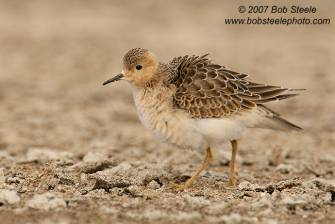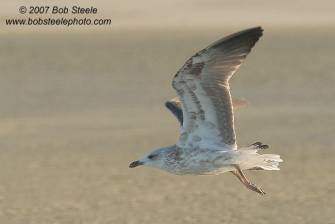[Originally appeared in the Sierra Wave newsletter, Vol. 26, No. 3, Jan-Feb 2008 – click here for original with photos]
Each season brings avian surprises and this fall was no exception. Four species were found that had never been documented before in Inyo County and it should be no surprise that all four were found at the new Owens Lake. The habitat being restored has not been seen there for over a century and clearly supports the adage Build it and they will come. Because of ongoing construction the lake is not open to the public but several trained people are authorized to conduct shorebird surveys to document the impact of dust control measures on birds. These surveys, conducted every few days during spring and fall, are revealing the lakes avian secrets. It is hoped that after construction is finished some level of access will be returned to the public.
Ornithologically speaking fall is primarily August through November, the main time most birds are moving south, although a few do start earlier. All four additions were photographed, which is supporting evidence of the validity of the identification. Two of the species are sufficiently rare in the state that they will be reviewed by the California Bird Records Committee.

Buff-breasted Sandpiper, Photo by Bob Steele
On 30 August a juvenile Black Turnstone was found by Mike SanMiguel and remained for at least three days. This species, usually found along the Pacific Coast with only a few inland records, is more unusual inland in fall than in spring.
On 16 September a juvenile Curlew Sandpiper was found by Susan Steele. This species breeds in Siberia and winters in the Old World from Africa, through southern Asia to Australia. It has been seen in California about 36 times before this sighting; most records are along the coast, usually in fall, while the few interior records are usually in spring. This sighting is unofficial until accepted by the CBRC.

Lesser Black-backed Gull, Photo by Bob Steele
As if the fabulous four werent enough, Inyo was also treated to other slightly less rare species like three different American Golden-Plovers (2nd, 3rd, and 4th county records), a juvenile male Ruff (4th county record), an immature Long-tailed Jaeger (4th record), and a juvenile Ruddy Turnstone (11th county record). It is not surprising that all of these sightings occurred at Owens Lake as well. While the avian significance of this countys crown jewel will continue to grow as long as LADWP continues to enhance and maintain wetlands habitat there as a result of required dust control mandates, it will be a long time before it returns to its former status.
Tags: crow, gulls, plover, sandpiper
